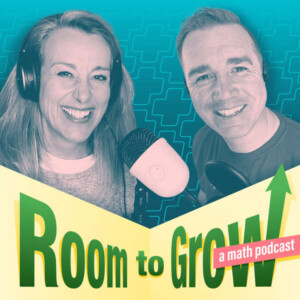In follow-up to our previous episode, this conversation shifts to a focus on teachers and how the Reason Routines help them to be more effective with more students.
We begin by talking about what makes teaching hard – including the fact that teachers make a million decisions every day in response to the students in the room and how they are engaging with the content; and that doesn’t even include the day-to-day challenges of interruptions, meetings, grading papers, and on and on! The routines are a support for teachers to use a structure for learning that frees them up to be responsive to the students in the moment.
As we learned in the previous episode, the routines help teachers to (a) focus on student thinking, (b) get out of the middle of learning, and (c) support students’ productive struggle. These concrete strategies engage all learners in mathematical thinking, supporting special populations from the start rather than requiring an additional set of approaches to support them. Additionally, the routines create student agency in mathematics, providing ways for students to listen to, engage with, and learn from one another.
You can go back and listen to episode 1 below if you haven’t already!
In this episode of Room to Grow, Grace Kelemanik and Amy Lucenta join Curtis and Joanie to talk about how routines can provide the “opportunity and support for each and every student develop mathematical thinking and reasoning.” Although routines are used by most educators for a variety of reasons, Grace and Amy focus on “Routines for Reasoning,” which are specifically designed and structured to surface the ways that students are thinking about the mathematics and to better understanding the reasoning of their classmates to reinforce the mathematics content and thinking goals.
In this extended episode, Amy and Grace dive deeply into the “Four Rs” and “Annotation,” two of the five “Essential Strategies” that teachers employ within the routines, with an emphasis on how these strategies provide access and opportunity for all students to engage in the deep thinking of the lesson. Then, they describe the “Connecting Representations” routine in detail to help listeners understand the power of the routines in action. As Grace shares, the power of the routines and essential strategies is that they help teachers to “hand over agency to the students. Teachers are no longer are the sole authority in the classroom… it’s the students doing the heavy lifting.”
Be sure to join us for part 2 of this conversation!
Heinemann Podcast: Teaching for Thinking with Amy Lucenta and Grace Kelemanik How Routines Help Teachers Make Shifts to let Students Think and Reason Mathematically Today on the podcast we’re joined by Grace Kelemanik and Amy Lucenta. In 2016 Grace and Amy co-authored Routines for Reasoning, where they framed routines as key to developing mathematical thinking skills. Their new book, Teaching for Thinking: Fostering Mathematical Teaching Practices Through Reasoning Routines, picks up where their first book left off, revealing how routines can enhance our classroom instruction.”
Highest Aspirations, An Ellevation podcast How can building routines for reasoning help reduce cognitive load and anxiety for English learners in math classes? How can strategies like Ask-Yourself Questions, Annotation, Sentence Frames and Starters, and The Four Rs help provide equitable access to mathematical thinking? What are some effective ways of teaching students the academic vocabulary necessary to have a seat at the math table? We discuss these questions and more in part 1 of our 2 part series with Grace Kelemanik and Amy Lucenta, authors of the book “Routines for Reasoning: Fostering the Mathematical Practices in All Students”.
Highest Aspirations, An Ellevation podcast What does a language-rich math classroom look and sound like? How do we get past simple repetition to reach a “harmony of concept and language” for English learners in math classes? How do we move from simply getting the right answer and move toward building metacognitive skills and why is this particularly important for English learners? We discuss these questions and more in part 2 of our 2 part series with Grace Kelemanik and Amy Lucenta, authors of the book “Routines for Reasoning: Fostering the Mathematical Practices in All Students”. You can read Grace and Amy’s bios on part 1 of this series. ines for Reasoning: Fostering the Mathematical Practices in All Students”.
Heinemann Podcast: Building Routines for Reasoning with Amy Lucenta and Grace Kelemanik How can we ensure access for all students in the math classroom? Today on the podcast we’re joined by Amy Lucenta and Grace Kelemanik. Amy and Grace are co-authors of Routines for Reasoning: Fostering the Mathematical Practices in All Students. Amy and Grace are big proponents of helping students develop their mathematical thinking and reasoning skills, and say that building routines into math instruction is one way to do that. We started our conversation by asking: “what does routine look like in a math classroom?”

